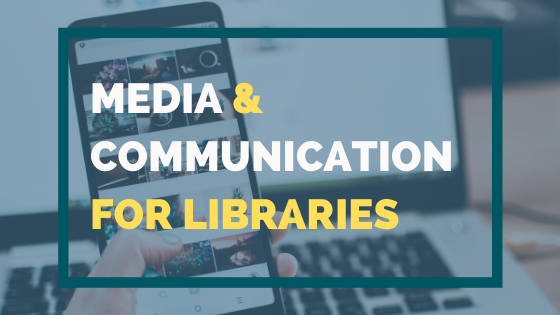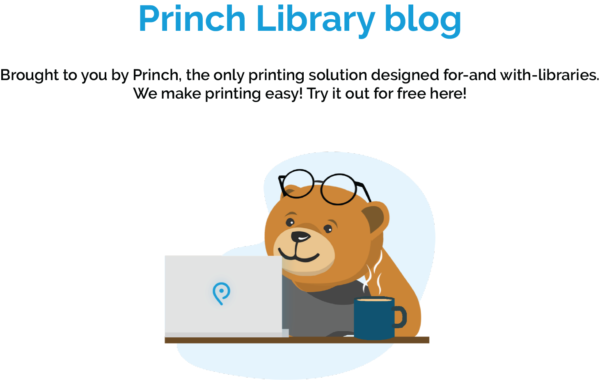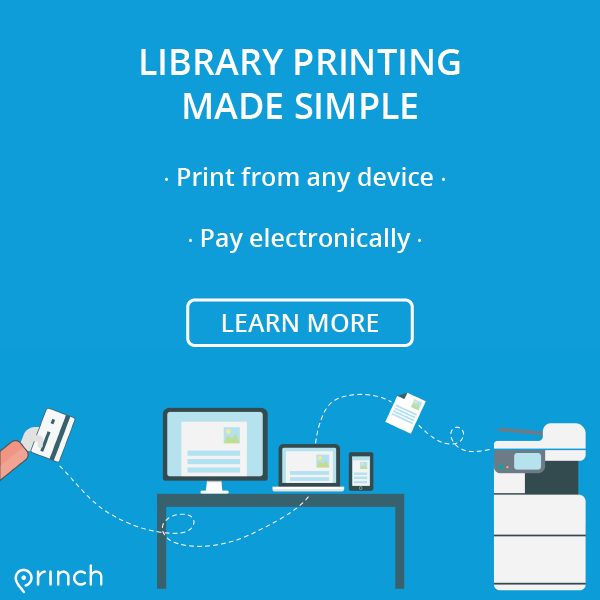On this week’s Princh Library Blog post we have guest writer Fallon Farokhi, school library media specialist, sharing her thoughts on the currently available media & communication tools for libraries, and how to take advantage of them.
Libraries are natural hubs for information and resources. Who better to communicate those services and materials than librarians? No matter what the mission statement of the library is, the targeted audience wants to know what resources are available to them and how the library can be utilized. Librarians who use traditional media outlets can continue to use them since they are still as important as ever, but with the addition of social media to the mix, there is something for everyone.
Some questions to consider before upping your media and communication practice:
- How would you describe your library’s brand?
- How are the brand’s values, actions and beliefs reflected in the media it creates?
- How does the library fit in with the community it serves?
- In what ways can you feature the people who make the library function?
Advertising
Approach your media and communication tools as advertising or advocacy mechanisms. Showcasing the books and other items available for circulation, use, and services should be a staple in your posting. If the library is being used by a community group or serves as another functional space, for example an art gallery, it will benefit your library to share those moments. Another way to advertise what you have is by asking your patrons and staff members to give a testimonial to their favorite part of the library. Sometimes the public won’t even know about those special features unless a real person points them out.
Photography
Your space, its materials, and services can be captured by strong photos. A picture truly is worth a thousand words when trying to communicate with the public. Experimenting with lighting, angles, and filters will improve the quality of your photos. It also helps to save photos that stand out to you in other library and business postings. Getting inspiration from others who are promoting their brands as well can lead to improved media coverage of your library.
Broadcasting & Podcasting
Broadcasting live from the library may feel like a nerve-wracking experience, but there are many people who do this and actually enjoy it. Live streaming from the library can give a feel to the space and present a personality to the public. An enthusiastic staff member could help with a short greeting to get started at first and then give a view of something interesting happening in the library. In addition to or in place of broadcasting live, you can film short segments and share those after editing the clips. A time lapse video with added music and titles is another way to share what the library has to offer.
Podcasting is different venture to reach another segment of your audience and there are a number of ways you can create a podcast for your library. One way is to rotate the hosting duties to various departments to inform the public about what they are working on that is of interest to the public. An alternative format is to make the podcast an interview show. Authors, illustrators, publishers, other librarians, patrons, community members, could be guests on the show. Additionally, if your library has a teen, youth or children’s advisory board of some sort, they could be involved in selecting topics and help to record the episodes.
Websites & Blogs
A library’s website provides a landing place to feature the library’s resources and services. It also connects your audience to the rest of the library’s media outlets. An organized website can help a user understand how the library can support them in what they are seeking. If you already have a library website you can ask for feedback from different patrons and get a sense of how user-friendly it is and make adjustments based on their suggestions.
Blogs are excellent ways to focus on specific topics. Approaching this as a type of podcast is beneficial because it is a way to rotate the authors and format. Each department in the library can spotlight a collection, a theme, an important figure, or a new event that the audience would want to know more about. Blogs can also be good places to interview authors, illustrators, community members and staff members about their work. One positive note about blogs is that they can have other media, like live links, videos and GIFs embedded into them which makes it more dynamic for the reader.
Newsletters
Your stakeholders and patrons find value from reading what you are doing in more detail than social media posts, but shorter than blog posts. A newsletter usually has the same format each time with up to date information about events, new materials, and changes in services. Newsletters are ideal for advertising new parts of the library and connecting the audience with the library’s other media outlets.
Social Media
Who do you want to reach? Every type of social media has a target audience who would most likely view and interact with your posts:
- Facebook is for middle age to older users who can readily share posts and interact with the posts’ information.
- Instagram is for a younger audience, teen to middle age who want more photographic and video imagery with limited ways to interact with the posts.
- Twitter’s average user is in their mid-20s and up. They are looking for shorter content and conversation, but also for networking and building community. Politicians, companies, news, and media outlets often have Twitter accounts.
- TikTok is heavily used by teens and is mostly for sharing short videos with labels, dancing or lip synching.
One way to reach your target audience on social media is to use and follow hashtags # that go with post topics. A strong community exists on social media so you can follow other libraries, booksellers, educators, authors, illustrators, publishers, and community groups with which your library account can interact. You can reach an even wider audience by tagging other accounts and users in the library’s posts, too.
Overall, there is a range of media and communication tools that librarians have at their fingertips. As more media formats and purposes for communication evolve, the library can continue to serve as the ultimate subject – with its use, updated materials, programs, and special place it holds in the community.

F. Fallon Farokhi
F. Fallon Farokhi is a school library media specialist at Sunset Hill Elementary in USD 497, Lawrence Public Schools, in Lawrence, Kansas. She has been an educator for 16 years in three states and a librarian since 2010. Farokhi has presented and published peer reviewed articles on technology and literacy topics at local, state, regional, and national educational conferences.
Blog: www.thestoryspectator.blogspot.com
Twitter: @ffarokhi
Instagram: @sunsethilleagleslibrary
Email: fallon.farokhi@usd497.org
Recent posts
Green Libraries: How Sustainable Design is Shaping the Future of Public Libraries
In this week's Princh Library Blog post, recurring guest writer Sam L. Bowman discusses an ever so important topic: sustainable design and [...]
Librarians Supporting Digital Literacy in the Community
In this week's Princh Library Blog, Nina Grant covers why digital literacy is important, the variety of ways in which librarians are supporting [...]






Leave A Comment